As queer people of color, there aren’t many characters on TV or in movies that reflect our various experiences. Sometimes we’re lucky and there’s a character on screen that we can totally relate to or at least can catch glimpses of ourselves in their storylines. When that happens, we’re able to relate and connect to someone who looks like us and moves through the world like us. It allows us to celebrate and cry alongside the characters who remind us most of ourselves.
Last week, Netflix launched a new campaign called #FirstTimeISawMe and asked actors and directors of color when was the first time they saw themselves on screen. The conversation moved to Twitter where people of color continued to share which characters made an impact on them, either because they looked like them or encompassed other identities they rarely saw on screen. It’s a reminder that there are still many, many compelling characters and plot lines to be written for more inclusive representations on TV and in film.
Here are the characters that made our queer writers of color feel most seen.
Kalinda Sharma, The Good Wife
Kayla, Staff Writer
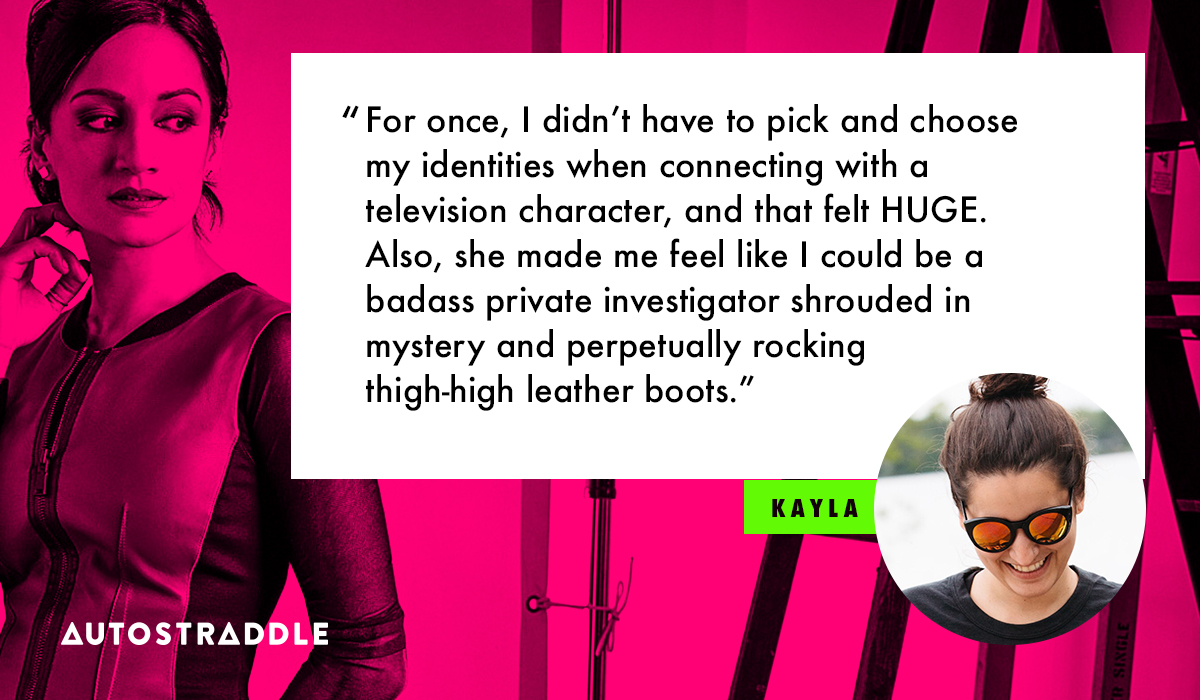
I love television, but out of all of the television shows I’ve watched in my lifetime, there have only ever been two female characters who are South Asian and queer like myself.
This means I usually am forced to identify with straight Indian characters or with white queer ones. Which is why, even though I’m not a badass private investigator shrouded in mystery and perpetually rocking thigh-high leather boots, I felt extremely seen when The Good Wife’s Kalinda Sharma came out as queer. For once, I didn’t have to pick and choose my identities when connecting with a television character, and that felt HUGE. Also, she made me feel like I could be a badass private investigator shrouded in mystery and perpetually rocking thigh-high leather boots.
Margo Hanson, The Magicians
Tiara, Staff Writer
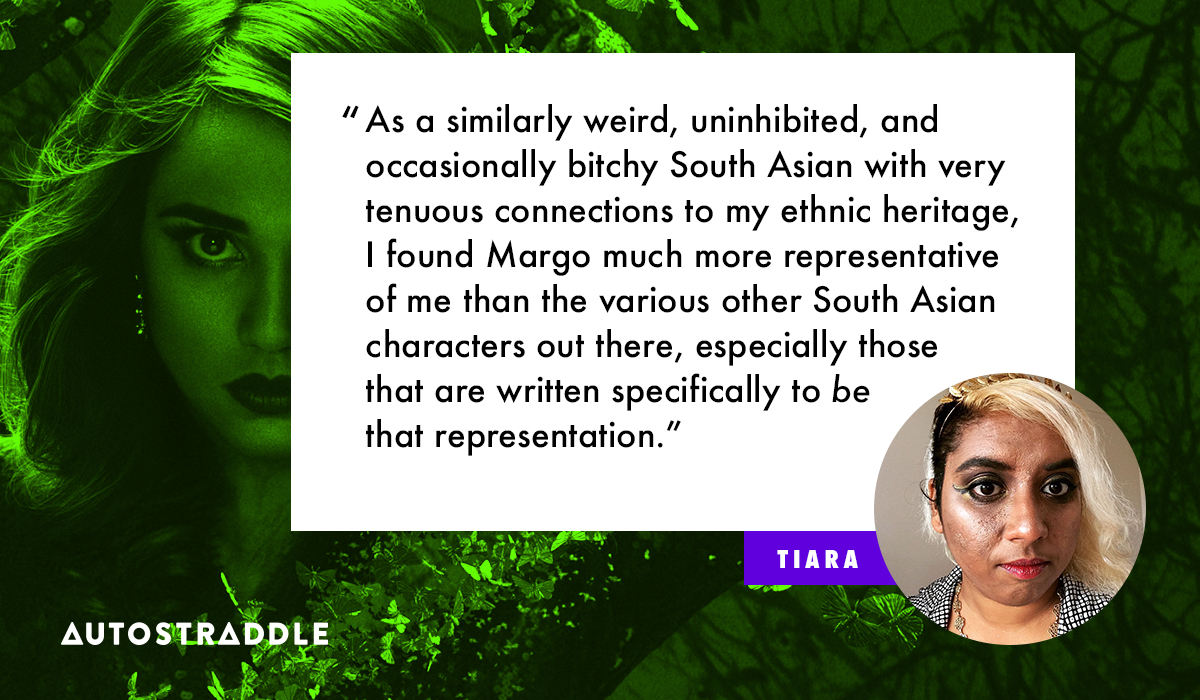
I couldn’t stand the book version of The Magicians; I found Quentin utterly insufferable and thought literally every other character was much more interesting. I only started watching the TV series a couple of months ago and was surprised at how much I liked it — mostly because they actually did focus on other characters besides Quentin (and he himself is more bearable).
One of the characters that most stood out to me in the TV version was Margo (Janet in the books). She was a lot more Mean Girls-y in Season 1, but in Season 2, as one of the High Queens of Fillory, she channeled that energy into being High Bitch in Charge — using her temper, intelligence, cunning, and fierce loyalty to demand real change, protect those she loves, and fight the fantasy patriarchy.
What I appreciated about Margo was that, like me, she’s South Asian — but her South Asian-ness is not really a thing in the story. She’s not some walking Bollywood Princess stereotype lampshading her cultural background every five seconds. I personally find a lot of representations of South Asians in media, both Western and otherwise, to be somewhat frustrating because they often make those characters As Hindu-Indian as possible: a very Hindu name, discussions about saris and spices, their homeland being brought up a lot. My family’s Bangladeshi-Muslim culture is already not very well represented outside Bangladesh, but even in that world I am an outsider: I wasn’t really raised in that culture, I have an English word as my name, my attitudes and beliefs are generally very “Westernised” (or just “foreign”). Even diasporic literature and art doesn’t really speak to me: they often speak of a Western diaspora (not an Eastern diaspora like my family) and there’s much more of a longing or desire for a romanticized version of The Motherland that I don’t necessarily relate to.
Margo is weird, she’s sassy, she’s comfortable in her sexuality, she owns her power and doesn’t back down from being a bitch when she needs to be. She doesn’t make a big deal (or any deal) about her ethnic heritage, and she doesn’t need to. She just is. As a similarly weird, uninhibited, and occasionally bitchy South Asian with very tenuous connections to my ethnic heritage, I found Margo much more representative of me than the various other South Asian characters out there, especially those that are written specifically to be that representation.
Also, as a massive fan of romantic friendships, her friendship with Elliot was so wonderful and beautiful to watch. Those two have their own separate romantic and sexual interests, but they are each other’s Most Important People; they are affectionate, loving, emotionally intimate, ride or die. I don’t get to see many representations of romantic friendships in general, and this one was especially poignant to me as Elliot is a lot like one of my best friends, Sebastian, who I also have a similarly intense, intimate, and affectionate friendship with. That Elliot and Margo look and act very much like more Slytherinny versions of Sebastian and I is an amazing bonus!
Yolanda, Mosquita y Mari
Yvonne, Senior Editor
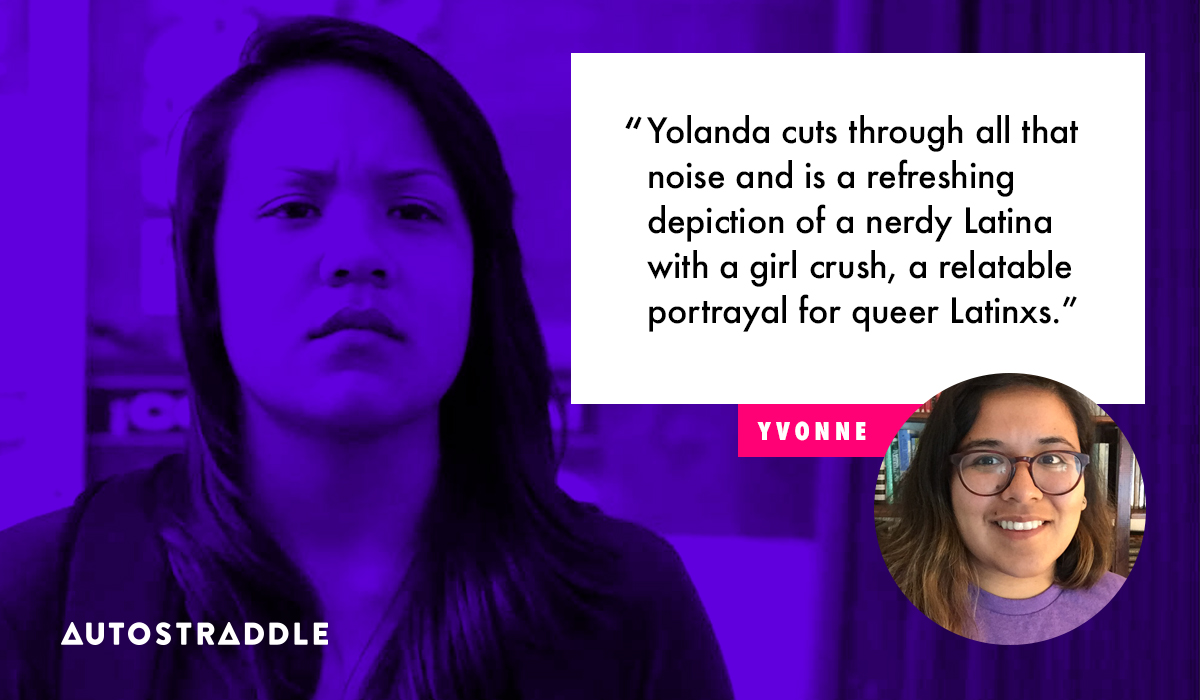
I watched Mosquita y Mari at a special screening in college, followed by a Q&A with writer and director, Aurora Guerrero. In that lecture room, my heart fluttered, I cried and I saw myself for the first time on screen in Yolanda, a quiet, studious teenager from Boyle Heights.
Mosquita y Mari is probably the only genuinely good representation I’ve seen of queer Latinas but I connected to Yolanda on a deeper level. She was the good girl; she listened to her strict parents, was a straight-A student, and she never got into trouble. I was totally that girl in high school! Yolanda forges a friendship with an unlikely classmate Mari, who’s a little rebellious and has to work to help her single mom with bills. Yolanda is drawn to Mari’s spirit and in turn learns to take herself a little less serious, something that many different people have done for me in my lifetime. Representation for Latinxs in television and movies is abysmal and still relies heavily on stereotypes — maids, criminals, “exotic” lovers. Yolanda cuts through all that noise and is a refreshing depiction of a nerdy Latina with a girl crush, a relatable portrayal for queer Latinxs.
Annalise Keating, How to Get Away With Murder
Natalie, TV Recapper/ Contributor
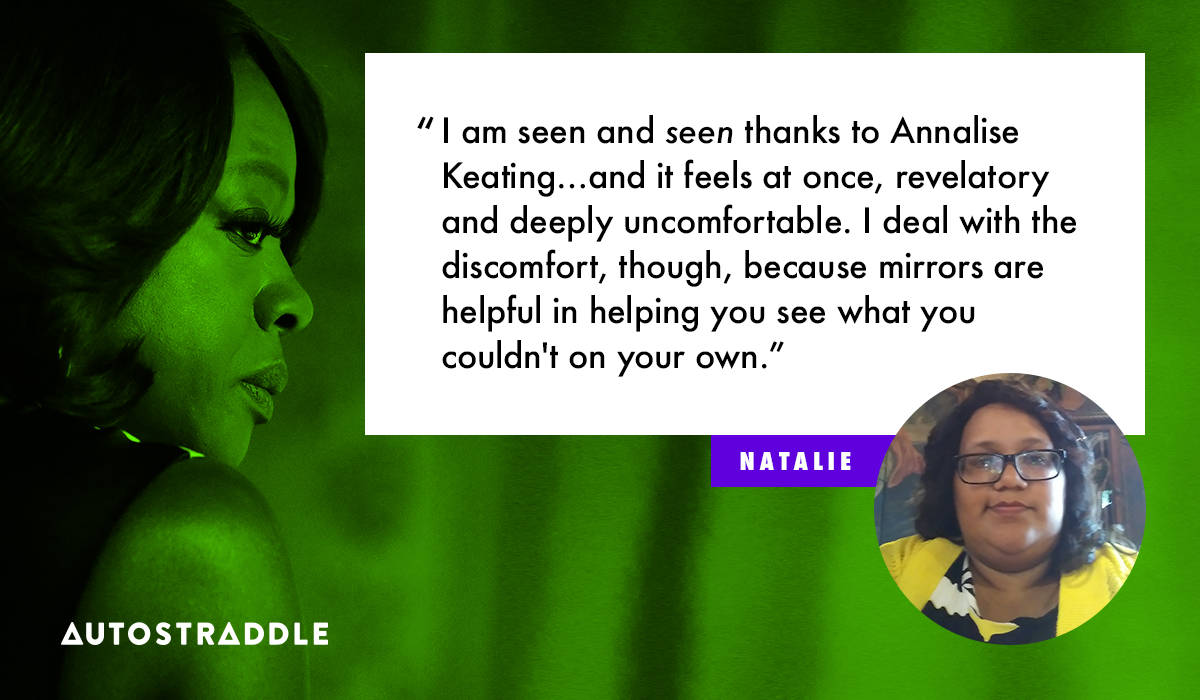
There are shows and characters that make you feel seen and then there are those that make you feel seen. The former feels like a complete triumph, like part of yourself has been vindicated because this character looks like you, talks like you, loves like you or whatever. The latter feels like you’re being exposed, like someone ripped out the pages of your diary — the ones where you confess things you never wanted anyone else to see — and put them on television.
Annalise Keating does both of those things for me…I’m seen and I’m seen.
It’s hard to divorce my love for Annalise Keating from the woman that plays her because so much of what makes me feel seen is that she’s portrayed by someone that looks like Viola Davis. Annalise Keating is a dark-skinned black woman, who isn’t a size zero and whose natural hair hides beneath impeccable wigs. Hollywood has a very narrow definition of what a beautiful black woman ought to look like —cough Halle Berry cough — and Viola Davis upends all of that.
But as the show progresses, the ways in which I’m seen shifts.
I cheer the moment Annalise pulls Eve Rothlo into a kiss. A black queer character, who gets to kiss Jean Grae, leading an entire hour of television? I live. I am seen.
But, I’m seen in the moments in which you realize that Eve loves Annalise with her whole heart —and, maybe, Annalise loves her back — they’re never going to be together long-term. Years of abuse have left Annalise convinced of her unworthiness. She doesn’t deserve something so pure.
“Men take things,” Annalise’s mama tells her. I need not be reminded of that fact. I am seen.
But I shatter inside when Annalise tells Nia, who’s been begging for Annalise to hasten her suffering as repayment for sleeping with her husband: “I think about it a lot, killing myself. I have ever since I was a child. A lot of times, I think the world would be a much better place without me in it, but I don’t do it. You’re a better woman than me and if I don’t deserve to die, then you definitely don’t.”
I’m grateful no one’s in the room with me when she says it…I can feel the tears sliding down my face and my hand shakes as I reach for the remote. I am seen and if anyone else were in the room that night, they would’ve seen Annalise Keating for the mirror she’s become for me.
I am seen and seen thanks to Annalise Keating…and it feels at once, revelatory and deeply uncomfortable. I deal with the discomfort, though, because mirrors help you see what you couldn’t on your own. Plus, I feel obliged to cheer for Annalise and hope, beyond hope, that she’s able to mend herself…because I’d like to see myself in that too.
I do, however, wish that Pete Nowalk would give me my diaries back, though…
Gosalyn Mallard, Darkwing Duck
Alaina, Staff Writer
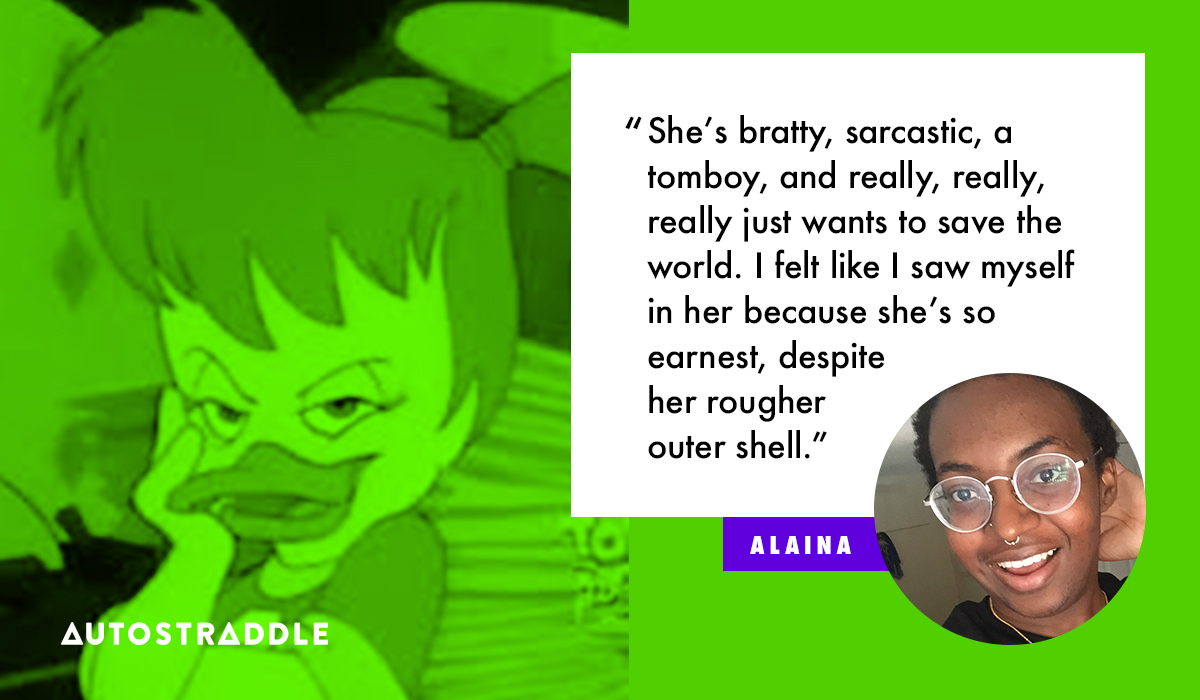
Gosalyn is the adopted daughter of Darkwing Duck. She is hilarious. She’s bratty, sarcastic, a tomboy, and really, really, really just wants to save the world.
I felt like I saw myself in her because she’s so earnest, despite her rougher outer shell. And boy oh boy, is that me. It may take you seven years to get to really know me, but I care so deeply about everything and everyone I love that sometimes I literally feel like I’m going to explode. Plus, we both look really good in jersey dresses.
Margaret Cho, All-American Girl
KaeLyn, Staff Writer
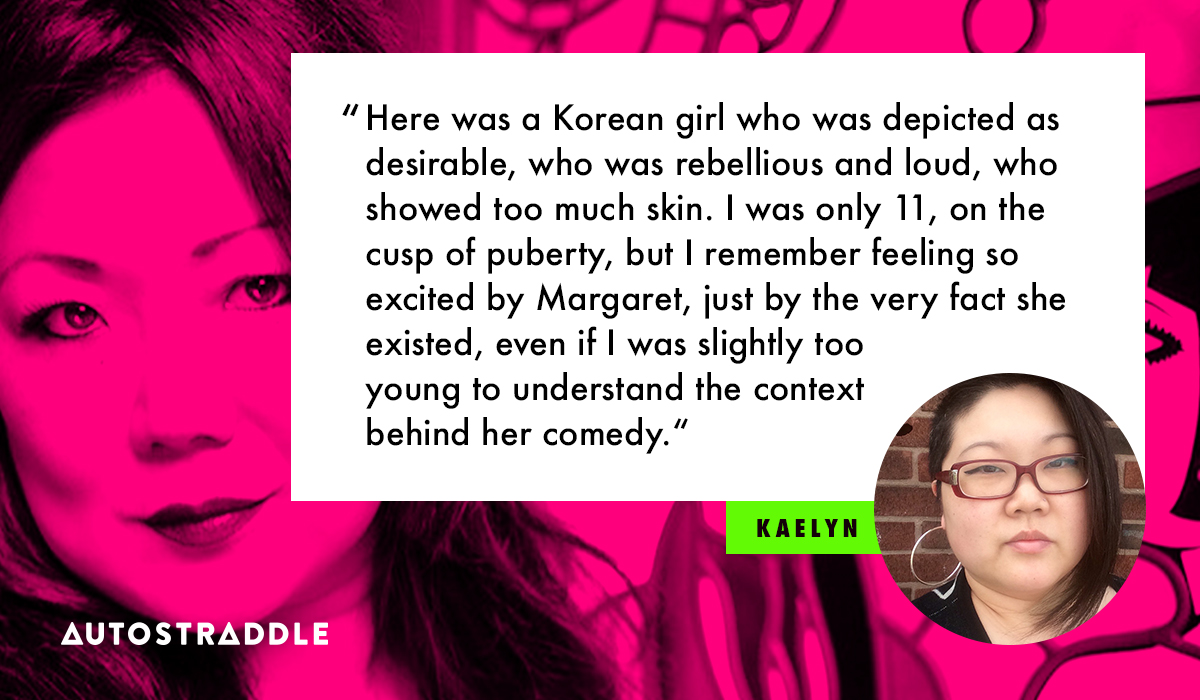
There are literally three TV shows featuring Asian families that have ever existed in the U.S. and two of them are on right now (Fresh Off the Boat and Dr. Ken). All-American Girl was a blip that you may have entirely missed because it only ran for one season. It was loosely based on Margaret Cho’s standup comedy, but really it wasn’t at all. It was rife with stereotypes, made to pander to white audiences, and produced and written by non-Korean people. It was my favorite show.
My whole family—my white parents and my Korean sister and I—would sit down together every week to watch Margaret fight with her mom, hang out at the mall with her friends, date white boys, and sneak out of the house in skintight leather mini skirts. It was super flawed representation and Cho wrote frankly in her memoir I’m the One that I Want that doing the show literally nearly killed her. But it was everything to me.
In 1994, there was barely anything on the internet for Asian girls. The internet was barely a thing, at all. I was constrained to print teen magazines full of faces that looked nothing like mine. My sister and I were the only Korean kids in our whole school. I didn’t have anyone I could identify with except white people in every part of my life. Seeing Margaret on television made me feel seen. Here was a Korean girl who was depicted as desirable, who was rebellious and loud, who showed too much skin. I was only 11, on the cusp of puberty, but I remember feeling so excited by Margaret, just by the very fact she existed, even if I was slightly too young to understand the context behind her comedy. I didn’t understand all the built up internalized racism I was holding inside, but I could relate to the feeling of being between worlds.
When I was older, I watched her stand up specials and collected them on VHS. I read her book. I watched her reality tv show. I got front row tickets to her touring show. When I started going out to the gay bar in college, the drag queens nicknamed me Margaret Cho and it was kind of racist, but also I didn’t care because I loved her that much. Like her caricature of herself on All-American Girl, Margaret Cho is not perfect, but she’ll definitely always be one of my very first queer Korean roots.
Cristina Yang, Grey’s Anatomy
Laura M, Staff Writer
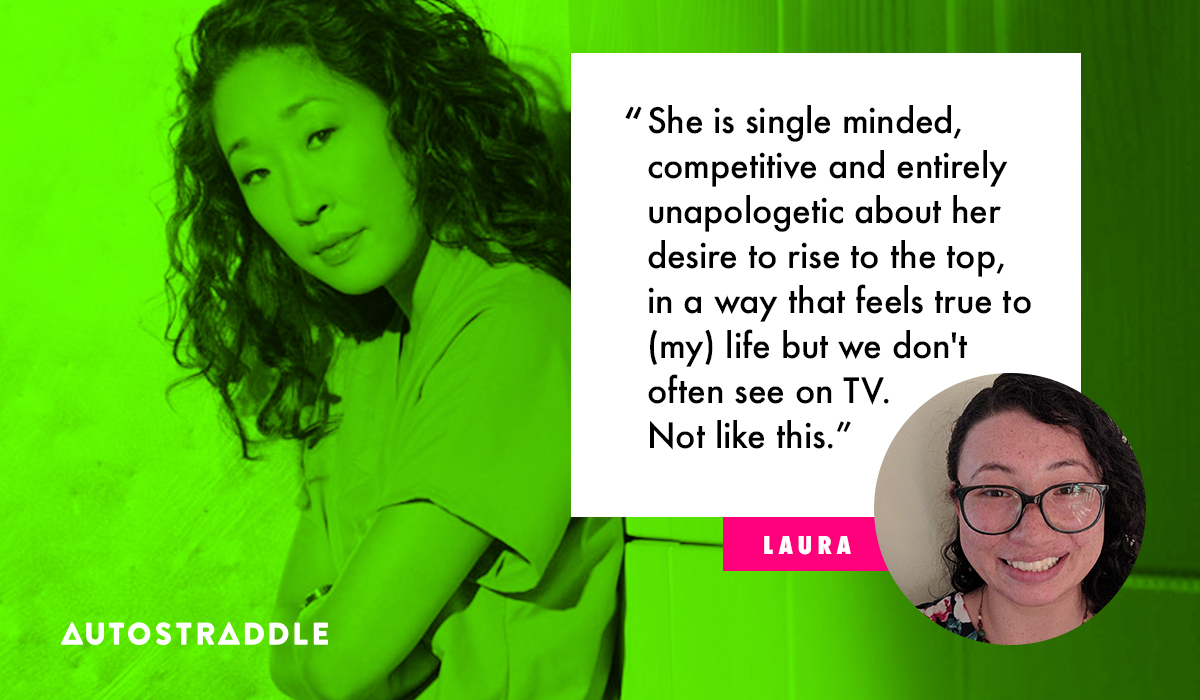
I LOVE CRISTINA YANG. Among other things, she’s a brilliant surgeon, an excellent dancer, and a loyal best friend — but the thing I admire most about her is her ambition.
She is single minded, competitive and entirely unapologetic about her desire to rise to the top, in a way that feels true to (my) life but we don’t often see on TV. Not like this. Cristina is sarcastic and can be socially off-putting, but never once did I feel like she was being punished for prioritizing herself she aggressively pursues her goals. It’s beautiful. She’s a knife (not a spoon), and she’s going to stab you in the eyeball. I totally relate.
(Also, her love life: she’s not queer, but she is habitually getting into it with smart, ambitious, successful people who are or were in direct positions of power over her. I also relate/feel very called out by that. It’s fine!)
Next up: Raquel, Priya, Alexis, Mey, Carmen, Neesha, Reneice
Wonder Woman, Wonder Woman Comics
Raquel, Staff Writer
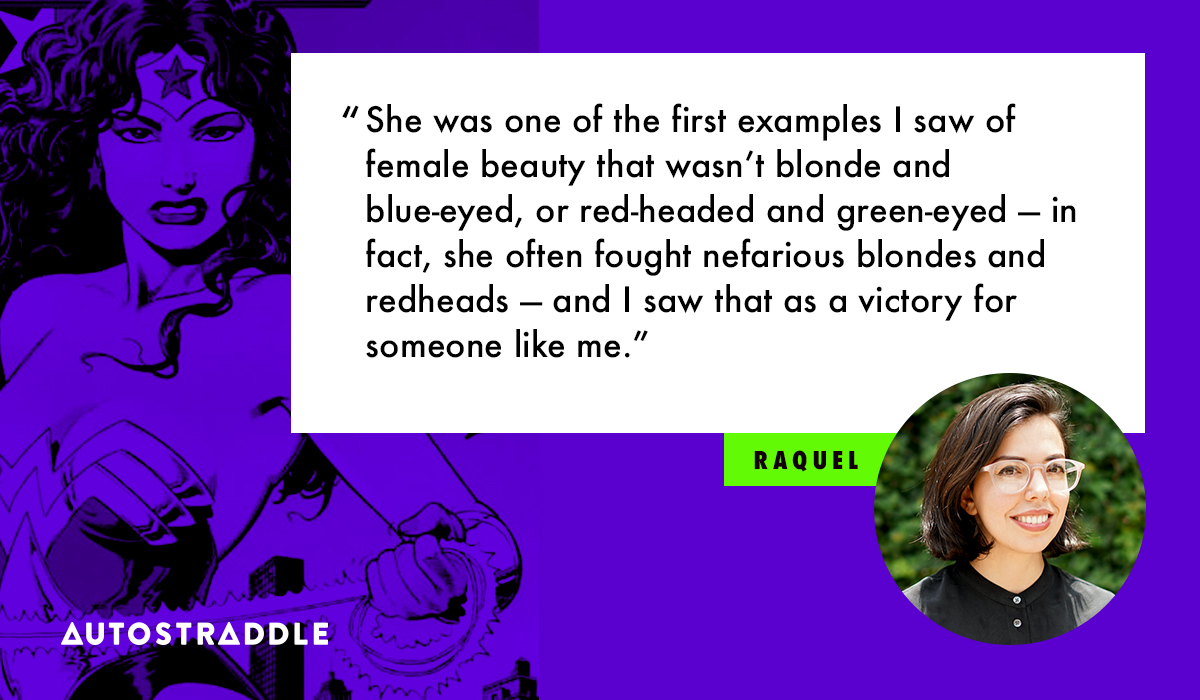
So, I’ve only recently discovered Wonder Woman is, apparently, white.
In my canon, I don’t accept that. When I was a kid, I heard she was a member of a tribe of Amazons and naturally assumed that meant she lived inthe Amazon, making her a dark-haired Brazilian like me, and like my grandmother. I knew something about how one of my great-grandmothers was part of an Amazonian tribe (though not a warrior tribe as far as I knew), and I imagined her like Diana Prince (apparently, the name did not throw me off here).
I loved Wonder Woman for this. I devoured any of her early comics I could (I couldn’t get my hands on many, because my mom took objection to her skimpy outfits). I looked to her as the ideal adult Brazilian woman, which, considering what I was seeing a lot of in my American childhood, was much better than my other examples. I loved that she stood for goodness and for truth, deeply appreciating her lasso in particular. I wanted to grow my hair long and dark like hers and jump around on things. She was one of the first examples I saw of female beauty that wasn’t blonde and blue-eyed, or red-headed and green-eyed—in fact, she often fought nefarious blondes and redheads—and I saw that as a victory for someone like me. It helped me accept my own dark features, which as a kid I was convinced made me hopelessly ugly.
As problematic as parts of this may be, Wonder Woman helped me feel like I could be beautiful, and that I could be a badass.
Callie Torres, Grey’s Anatomy
Priya, Staff Writer
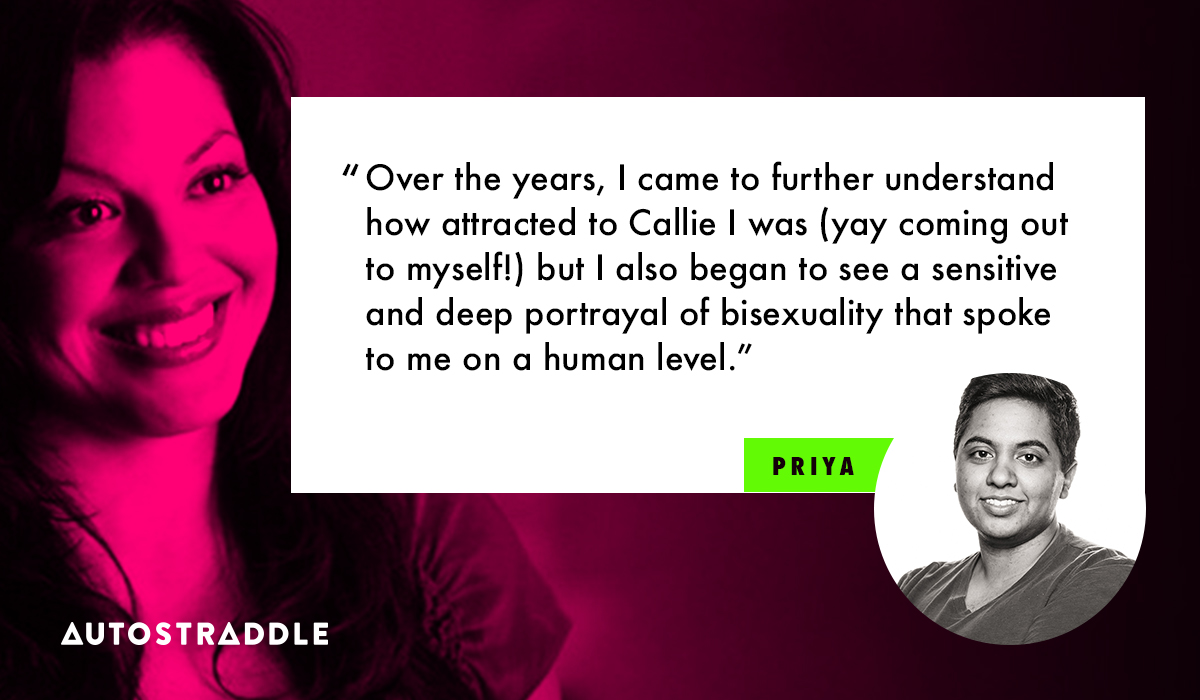
Callie Torres is one of the great, true loves of my life. From the moment she stormed onto the screen to save George from his inexplicable pining over Meredith, Callie’s beauty, humor, mysteriousness, and zing for life completely captivated me. Over the years, I came to further understand how attracted to Callie I was (yay coming out to myself!) but I also began to see a sensitive and deep portrayal of bisexuality that spoke to me on a human level.
I have, in the years since the divulsion of her same-sex attraction, watched and re-watched Callie and Arizona scenes until the cows came home. Callie, a fierce Latina woman, faced the turmoil of coming out to her conservative family, and tested her faith when it came to her sexuality—and though she came damn close, she did not break. Her storylines always made me feel like I wasn’t alone. That I, too, could face my dad the same way, have a partner whose fierce love would win over my family, and that the dream wedding, and even kids, could be a normal, yet so deeply profound, reality.
As a strong and beautiful bisexual woman of color: Callie, you were so much more than that, but long after I was over the show, you kept me locked in. Your loss for Grey’s as a show, and on my tv screens every week, fills me with profound sadness even now. But I’ll always have the fondest of memories and the bingiest of rewatches, Calliope Iphenia Torres.
Regina Mills, Once Upon A Time
Alexis, Staff Writer
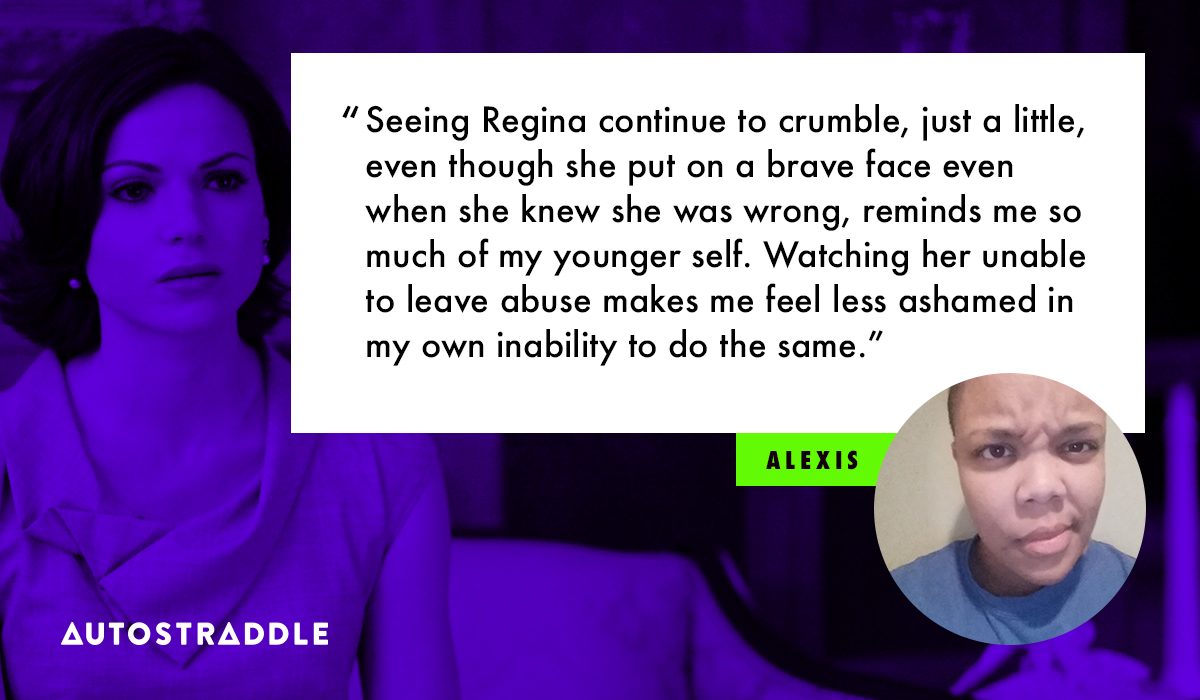
I had a fucking existential crisis over Regina Mills okay. I remember marathoning the first season on Netflix on my couch after coming back from the second or third college within the span of two months and thinking she was totally in the right to fuck everyone’s life up. Though I didn’t know it at the time, it was one of the ways that lead me to understanding my trauma. After finding people explain Regina’s abuse and how much of her character’s actions fell under PTSD, I had to really sit down and think why I was so affected by her.
I’ve stopped watching Once Upon A Time and turned to fanfiction and Tumblr gifsets for Swan Queen. But at least part of canon Regina Mills has burrowed her way into my heart because of the soft Lana Parrilla gives us when we least expect it. When her mother was given her heart back and told her that Regina would’ve been enough, I was a mess for days. Realizing the potential of life without abuse, having that impossibility so close, only to have it taken away at the last moment, was more than I could take. Seeing Regina continue to crumble, just a little, even though she put on a brave face even when she knew she was wrong, reminds me so much of my younger self. Watching her unable to leave abuse makes me feel less ashamed in my own inability to do the same. I love her very dearly. How can’t I think of all the ways abuse has invented us and see her?
Sort of unrelated but I also can’t listen to Total Eclipse of the Heart cause of her.
Santana Lopez, Glee
Mey, Trans Editor
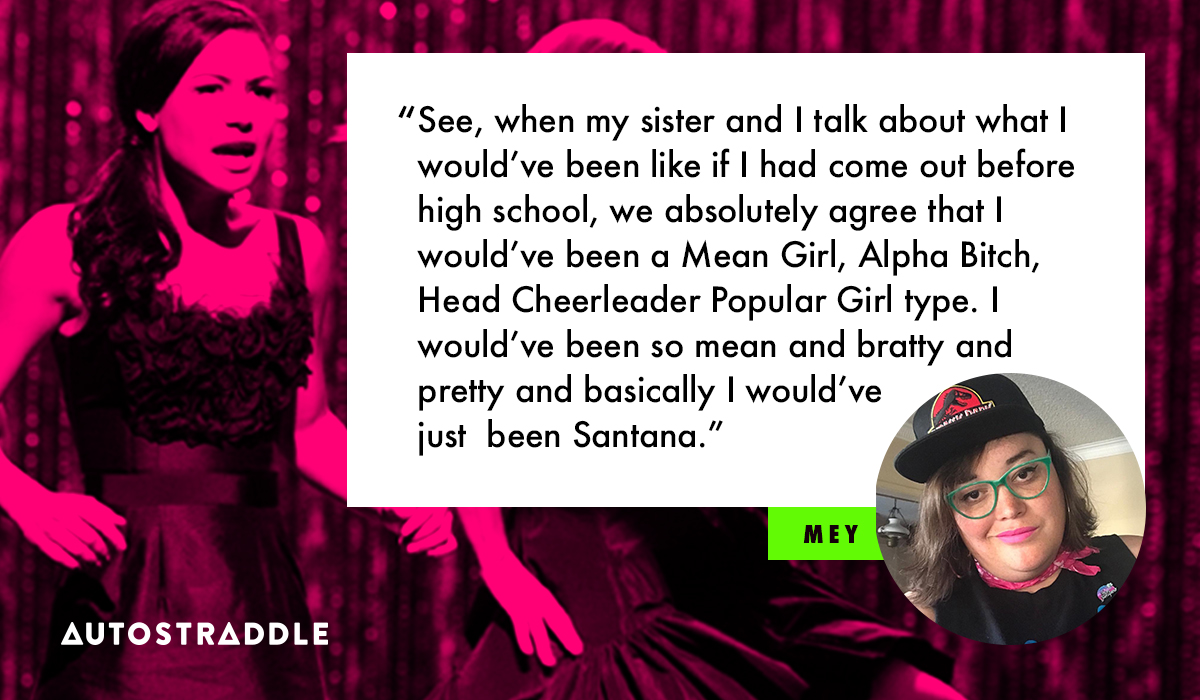
I started watching Glee when I saw on tumblr that there was a throwaway joke line about two girl cheerleaders hooking up, and even more importantly, I saw that one of the girls was a Latina.
After that, I was hooked and have seen every episode of Glee at least three times. See, when my sister and I talk about what I would’ve been like if I had come out before high school, we absolutely agree that I would’ve been a Mean Girl, Alpha Bitch, Head Cheerleader Popular Girl type. I would’ve been so mean and bratty and pretty and basically I would’ve just been Santana. For a while, there was no character in all of media that I loved more or related to more. When I was doing my third Glee rewatch, this time with my mom, and we got to the scene where Finn outs Santana and then she sees a political ad that will out her to her family, I cried harder than I had ever cried because of a piece of media. My mom had to pause the episode while I bawled for twenty minutes. I love Santana Lopez. The only straight she is is straight up perfect.
Moesha Mitchell, Moesha
Lena Adams Foster, The Fosters
Carmen, TV Recapper/ Contributor
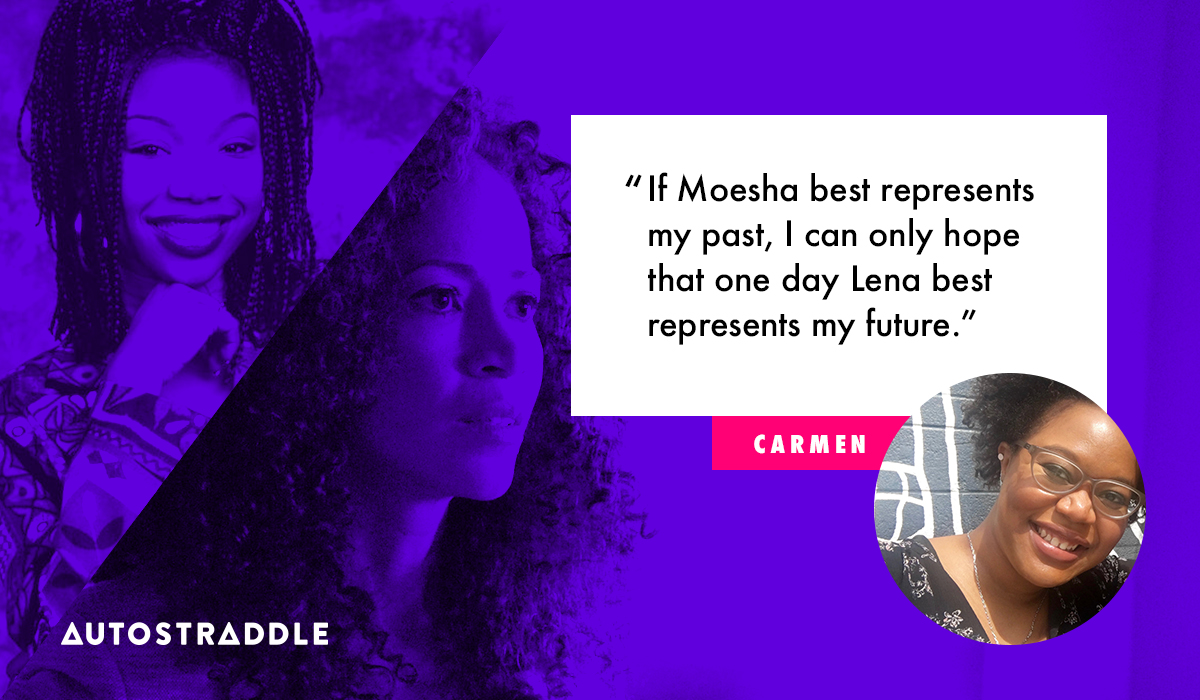
There’s an inexcusably thin amount of representation for women of color in pop culture, still I’ve been able to find fleeting glimmers of myself at different stages. When I was a kid, I loved Susie Carmichael, the black neighbor on The Rugrats who always looked out for the babies and was ready to protect them from the tyrannical reign of Angelica (Susie was an OG Social Justice Warrior). If you were to ask me as an adult looking back, no one has come as close to capturing my childhood personality as Diane Johnson on Blackish. Watching Santana on Glee or Callie on Grey’s Anatomy automatically transports me to my early 20s and how much their coming out stories meant to me. My relationship to the representation in front of me changes depending on how I’ve seen myself at the time. But, two characters almost immediately stick out from the pack.
Late 90s and early 00s black sitcom royalty Moesha starred R&B artist Brandy Norwood as the titular character. But, it wasn’t just my adoration of Brandy the singer that brought me to watch the show ad nauseam for over a decade. Moesha was smart and genuine. She loved hip hop music, poetry, and she loved writing most of all. She took her education seriously, and was thoughtful about the ways she could use it to help her community. Those were traits that I latched on to at a young age. There are few other characters who could better represent my adolescence (though, as a prototypical awkward teen, my clothing was not nearly as fly).
Nothing makes me feel as brave to love openly or dream big as watching The Fosters. It came into my life just as I was ready to imagine: What comes next? I still haven’t figured out exactly how to get from point A to point B; but I know that a loving wife, a family that looks out for each other and their community, and an open floor plan kitchen all sound like a pretty ideal place to end up. Like me, Lena’s a mixed race black woman with big hair, lefty politics, and an educator who cares about LGBTQ+ kids and kids of color. If Moesha best represents my past, I can only hope that one day Lena best represents my future. Plus, I’ve had more than one person binge The Fosters on Netflix over the last few years and then text or email to say, OMG THIS IMMEDIATELY MADE ME THINK OF YOU!!! And trust me- no one is thinking I’m Stef in that scenario ;)
Jessi Ramsey, The Baby-Sitters Club
Neesha, Staff Writer
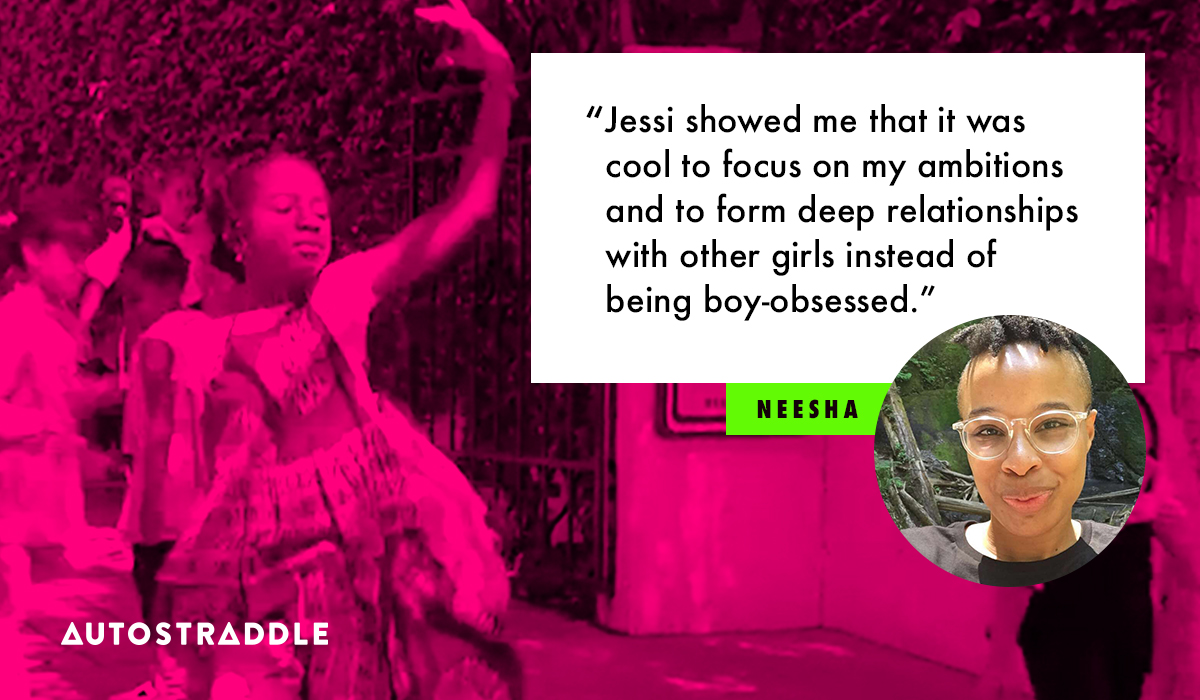
Once upon a time, I was a young capitalist. I didn’t necessarily want to start my own baby-sitters club (let’s be honest, I was too lazy for that), but I thought the members of the Baby-Sitters Club were the most entrepreneurial baddies in the land. Naturally, I gravitated towards Jessi, the only Black girl of the bunch. I shared Jessi’s love for dance, and we both took it very seriously.
The release of The Baby-Sitters Club movie was a major event in my 9-year-old life. Finally, I got to see Jessi in the flesh, and it was magical. I remember her character dancing anywhere and everywhere, just like I did. Jessi’s existence confirmed for me that Black girls rocked and that it was okay for us to have big dreams. I saw other Black girls on the screen sometimes, but a lot of them were fixated on being pretty and having the cutest, most popular boyfriend. That was so not me.
Jessi showed me that it was cool to focus on my ambitions and to form deep relationships with other girls instead of being boy-obsessed. I’m grateful that Ann M. Martin, a white lesbian, included her character in the series. She even wrote about Jessi celebrating Kwanzaa, which helped me learn a lot about the holiday that I hadn’t known before.
I wish Martin had given Jessi more Black friends, but at least there was Claudia Kishi, a Japanese girl who hosted all of the club’s meetings. Someone should definitely write fan fiction about Jessi and Claudia eventually marrying each other and settling down in NYC, where Jessi dances for the Alvin Ailey Theater and Claudia works as a museum curator. This is the stuff that QTPOC dreams are made of. <3
Olivia Pope, Scandal
Reneice, Staff Writer
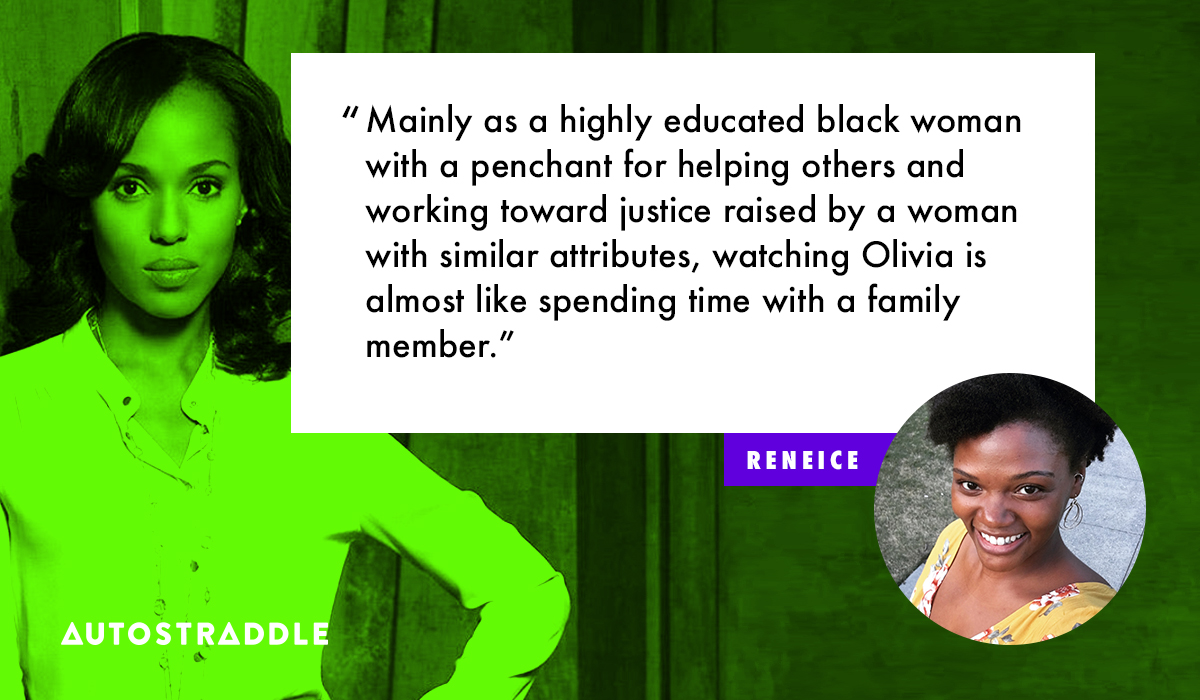
Save for the affinity for loving mediocre white men, I see many characteristics of myself and my experiences reflected in many ways in Olivia Pope which is why I love her so dearly.
The way she is expected to be composed and carry the world on her shoulders without breaking is too real. Her beauty and grace and fierceness as a boss in high stress environments reminds me so much of my mother, who spent her life shattering glass ceilings in corporate America, and who I inherited many traits from. I am a total wine snob, I just got a case delivered from the wine club I joined when I first watched Scandal and met Olivia Pope then got insanely jealous of her never ending supply. Mainly as a highly educated black woman with a penchant for helping others and working toward justice raised by a woman with similar attributes, watching Olivia is almost like spending time with a family member. She made parts of me feel seen and understood and represented and that is an amazing and rare feeling.
Pages: 1 2See entire article on one page


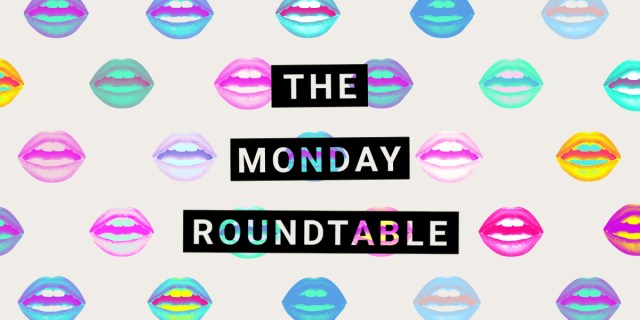

Not surprised to see so many Shondaland characters here.
Shonda Rhimes is the greatest, she’s the gift that keeps on giving.
Shonda Rhimes is SO important. I have more than once thought about sending her a “thank you” letter. Few others (if anyone else, really) on television have left such an impact on me, that’s for sure.
Send the letter! My grandma taught me that whenever you can make a sincere compliment or say something positive to someone else you should do it.
i loved reading everyone’s stories and learning about some new shows and I didn’t know existed! i hope we can see more of ourselves in the future <3
I absolutely adored this roundtable!!
I feel like I was able to learn a lot from/about everyone. It was definitely a good reflective exercise for me to participate in, but also I was pretty amazed how much you can learn from other people by listening to them talk about what pieces of (pop) culture have impacted them, you know?
It was a stellar idea for a roundtable! thanks to the editors for putting it together.
This was a great round-table, and would love to read more of these. It had me thinking about where I first saw myself, but that’s always been a tough as Persian’s aren’t the most positively represented on tv, or we play non-Iranian characters(Sarah Shahi as the relevant example).
I hear you on this! If I had to wait for a Bangladeshi-Malaysian character to show up…well that’s never going to happen. And even characters that are specifically Bangladeshi or specifically Malaysian aren’t always relatable. I end up finding my representation in unexpected places and people based on what they experience and talk about, not necessarily what their cultural background is.
That is true, more so now that more variety of LGBTQ voices are being heard, and isn’t terrible with certain characters like the L Word. I’m also Jewish so there is a decent amount of positive(r.e. non stereotyped) representation; but, then again most that is Jews of European decent, i.e. non-white(well white looking as racists don’t us as white).
@needlesandpin, I definitely agree with you about Persian representation on television…I tried to think of some and the only ones I came up with are fraught (Homeland) and terrible (Shahs of Sunset). The others are, as you said, not coded as Iranian.
Have you seen Life, Sarah Shahi’s short-lived NBC show? I really enjoyed the show and Shahi’s character, Dani, and I think it’s the only role Shahi’s played where she’s been written as explicitly Persian.
Was Life the one she played a teacher? Yes, Shahs of Sunset is mostly of terrible(though it does stereotype us in a different manner), though there are some in the community who would disagree.
No, not that cancelled NBC show starring Sarah Shahi, the other cancelled NBC show starring Sarah Shahi (ha!).
I’d forgotten all about Teachers. It was her first show post-L Word which didn’t even last a full season. I think her character was Mexican on that show.
On Life, Shahi was Detective Dani Reese, who after a stint in rehab, gets partnered with Charlie Crews (Damian Lewis), an LAPD detective just returning to the job after serving 12 years in prison for a crime he didn’t commit. It sounds bizarre, I know, but it’s really good and remains my favorite Shahi role to date.
The show, which lasted just two seasons (though Shahi’s maternity leave interrupted her run in the second season) is available on Netflix and Hulu.
Ah, okay that’s good know. Though it kind of stinks they had her playing Latinx on teachers when it could have easily been a Persian/Middle Eastern character.
Have you ever watched The Blacklist? Their is a great character on there named Samar. She is of Iranian descent(both the actress and character). A former Mossad agent who is recruited by the secret wing of The FBI to track down all the people on Reddington’s “blacklist”. She is such a badass character and kind of reminds of Kalinda in terms of how she carries herself.
No I haven’t, but I may have to check it out.
I hear ya Al. My grandparents were a Persian/Jewish couple, Mother was raised in Iran. On Dads’ side I’m Danish, which is easy to find some representation on TV. Why can’t it be the same for Persians?
I LOVED THIS. thank you all for sharing! i love being able to see a little bit of you in these characters now.
Oooh, I’m not much of a TV/movie person, but I like the sound of Mosquita y Mari. I was also very much a serious, rule-abiding, never in trouble, nerdy, straight-A student – though I had no idea back in high school that I was queer. Anyhow, I’m glad to hear that there is something out there where you can see yourself, @yvonne, in a realistic and beautiful way. Maybe I’ll be able to see a bit of myself (or who I could have been if I had a clue) too.
Loved this article. “Save for the affinity for loving mediocre white men…” seems like a good starter sentence for female characters in general.
I l-o-v-e-d reading this roundtable. Thank y’all for sharing so much of yourselves with us.
This is magnificent – it is always humbling to see how much media matters. Thanks to the roundtable members for sharing these parts of yourselves with us!
Thank you!
Yolanda, thank you so much for writing so beautifully about Mosquita y Mari. That is absolutely one of my favorite queer coming of age stories of all time in any medium. I highly suggest everyone check it out who hasn’t seen it yet!
Well I feel like a class A idiot and see that the characters name is Yolanda and it was written by Yvonne. I am sorry! Should be careful when quickly scrolling up especially on my phone. My mistake